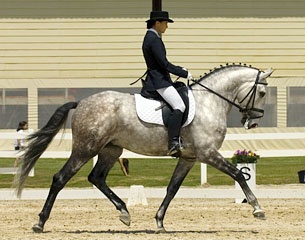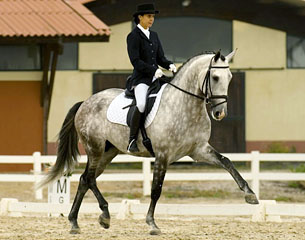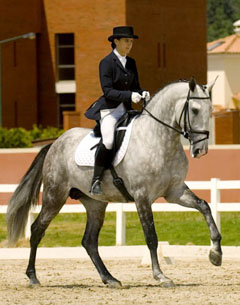
My decision to move to the stable of the great master João Pedro Rodrigues proved to be just the thing to boost the learning curve of both myself and my horse. In the beginning, the training was gradual, and we took time to properly establish the lateral movements. However, once the horse could find balance and cadence within the two and three track exercises, he gained new strength from behind, and with that a greater confidence in his ability to lift in front.
From there we advanced quickly and it was my Lusitano's own development that led naturally into the next phase of training: collection.
It was great to actually respond to my horse's own willingness to advance to the next level. It happened literally in the space of a week, Batialo suddenly decided he could suspend the movement, becoming more engaged and simultaneously more up in front. The work until now had been much more forward, using the lateral movements to help the horse build up strength behind and maintain the contact both in the straight and flexed movements.
It was important, before starting the collection, that the two track exercises were being carried out with both ease and purpose. A horse that slows in the shoulder-in and loses momentum and impulsion in the half-pass is not yet strong enough to develop true cadence within the gait.
These movements should be done with the lightest aid possible, developing a horse and rider connection based on sensitivity and quick response.
"In training the two-track exercises and the half pass, riders should use the aid every second step, to allow the horse time to cross his legs, without increasing his tempo" (N.Oliveira).
You shouldn't need to push the horse the entire time, and the term 'less is more' should always be in mind. "The secret in riding is to do few things right. The more one does, the less one succeeds. The less one does, the more one succeeds"
N.Oliveira (1998, 29).
Once the lateral work and basic gaits were moving forward with ease and I had basically just became a silent guide aboard my horse's back, I could move on to the collection.
Beginning the collected work was about establishing an elastic connection between my seat and the horses back. I started with lots of transitions, making sure the horse would respond only to my seat when asked to walk and only to a light touch of the leg in order to move back into the trot. From there the aid to walk became less and less, and gradually through the mere act of lengthening my breathing and widening my seat my horse would go smoothly into a forward walk. Going on and coming back, transitions within the movement, were then perfected with the use of a lighter half halt, so the horse didn't actually go to the walk, but came back under and engaged the hind quarters as if he was about to.
Kyra Kyrkland says "A half halt is when I could have halted if I wanted too, but I didn't." Once the horse is responding quickly to the half-halt, he begins to establish his own balance when you bring the rhythm back, and thus learns to collect himself.
Most important is that the minute the horse responds to the impulsion given by your seat, finds balance and cadence, and becomes soft over the back and light into the hand, you remain as still as possible for as long as possible, so he learns to maintain the collection himself.
"In order to achieve cadence, you impart good impulsion, and then you are as inactive as possible. Now the horse will cadence himself" (N.Oliveira). The less you interfere once the horse lifts and engages into a collected gait, the better. "Discontinuing the aids does not mean abandoning the horse, but to maintain the contact and to do as little as possible"
N.Oliveira (1998, 33).
Once the horse is listening to your seat, the use of small serpentines, and voltes, (8 metre circles), also help him to really sit himself (engage) and come under, whilst maintaining the slower tempo.
Collection in the canter is best perfected in counter-counter along the wall of the arena. In the normal canter the horse may collect but can get out of really engaging his hind legs by putting his quarters to the inside. In the counter canter along the wall the horse must remain straight into the collection, and therefore, hopefully, truly engage himself from behind.
 Once I started establishing collection in all three gaits, my trainer João Pedro said it was time to start practicing tests. Competition is simply the refinement of my classical training, and it was important now to not only have my horse going in the correct way, but to ensure I could produce this work, with precision.
Once I started establishing collection in all three gaits, my trainer João Pedro said it was time to start practicing tests. Competition is simply the refinement of my classical training, and it was important now to not only have my horse going in the correct way, but to ensure I could produce this work, with precision.
So I began practicing an M or medium level test, and it was great to see how easily Batialo could adapt his training, producing his best work in a closed environment. However the test also highlighted the areas I hadn't practiced, and the first time I halted and applied the aids for a rein-back, the confused look on Batialo's face reminding me that I had never asked him to go in reverse before.
So the test was paused a moment while JP helped me begin the rein-back. He approached the horse with a whip from the front and while I applied the aid he would lightly tap the horse on the front knee. The instant the horse took a step back, I would relax the aid, and João Pedro would step forward to pat the horses neck. After each section of progress, I would trot off on the half circle and begin the lesson again on the other wall. It took just four goes for Batialo to decide that was very easy, and JP was no longer needed as an aid in the reverse command.
From here we will continue to train the tests, perfect the movements, and work on the next step...the flying change.
The most important part of training... EVERYDAY... the walk. For at LEAST 10 minutes when you start the training each day, you should walk the horse with loose reins. This is not just important to allow the horse to relax and improve the quality of the walk by generating greater extension in the gait, but equally as important it gives the rider time to prepare, to set the tone of the lesson, to THINK about what is to come.
"In the calmness of the walk, horse and rider can find the time to think and to prepare the quality of the following trot and canter"
N.Oliveira (1998, 49).
It is this time when you can clear out all the stresses, bills to be paid, screaming kids, the "you want more money for your horses?" husbands, and focus on you and your horse. If you take these agitations into the lesson, your horse will know it, and you risk unfairly taking it all out on him.
Now it's easy to write an article on how to train, based on when things are progressing, but what seems to go untold are the many days when things don't go as planned. With a 5-year old stallion, the average is around 1 in 5, when even as I take Batialo out of his box, I know it's going to be a fun ride! I say that, like a dog can raise the top of his back, that Batialo has his hackles up, and that I need to ride with extra care.
It's on these days that I need to pay extra attention to the connection from my inside leg to my outside rein, ensuring his attention his always focused toward the inside of the arena, and not to what fun things the outside environment may offer up as a good excuse not to work.
This connection also sets up as easy small circle, should my strong, often childlike partner, try to take flight. For a horse that is easily distracted, or that you feel is getting out of your control, lunging with side reins can also help to reinforce the rein aid to stop and give the horse the knowledge that there is something to stop him when he takes charge of the rhythm. On the other hand a horse may be calm, but use a particular object to get out of the work.
For example, that scary instructor's chair, that is there everyday, in the exact same spot, but seems to become particularly daunting on those days when any excuse not to work will do. The best then is to slowly take the horse closer, to acclimatize him to the object. Is not the best idea to ride straight at it, as this will only draw attention to the thing he is afraid of. Try to start circles away from the chair, and slowly move the circle closer, keeping the horse in shoulder fore position, and pushing him out with the inside leg into outside rein. That way he will slowly approach the chair, while keeping him focused on the inside.
Flying changes are based on three very important foundations, straightness of the canter, ability to collect the canter (engagement of the hind quarters), and TRANSITIONS!
To prepare for the flying change, again, transitions, transitions, transitions, particularly, walk/canter, canter/walk, must be made immediately and from the lightest aid possible.
The horse must be sensitive, and jump into the canter with balance, and straightness, and complete the downward transition without losing impulsion or engagement from behind.
Once these transitions are perfected, three quarter lines in canter help to ensure the horse is straight and not relying on the wall for balance, then you may begin to ask the change, ensuring that the horse is brought quickly to walk immediately after the change to either reward, with a pat on the inside hand to neck, or to reprimand, this is where a reinback can be a useful tool, if the horse has no tendency to lift up.
My other horse, the more older and well trained of the two, is completely different, which is good for my riding and my ability to search for solutions.
His problems stem from his training history, and after 10 years working one way, moulding him to my way has taken some adjusting. The horse took my attention in the first place, because despite the obvious fact he was not working properly over the back, his transitions, particularly to and from piaffe/passage, were amazing.
 So to begin the work, it was back to basics, back to the snaffle bridle and back to slow serpentines and transitions, attempting to teach the horse how to stretch and remain forward without hollowing his back and coming up in front. His reaction to everything, was to hollow and put his head in the air, the 'praying mantice' I so lovingly call it! So convincing him that he could remain round and forward into the contact, and I wasn't going to stiffen against him, took some convincing.
So to begin the work, it was back to basics, back to the snaffle bridle and back to slow serpentines and transitions, attempting to teach the horse how to stretch and remain forward without hollowing his back and coming up in front. His reaction to everything, was to hollow and put his head in the air, the 'praying mantice' I so lovingly call it! So convincing him that he could remain round and forward into the contact, and I wasn't going to stiffen against him, took some convincing.
Gradually though he began to accept the contact, and loosen right through and over his back. But the process will be long, and it will be many months of stretching and lateral work before he will confidently move forward, while maintaining the swing in the trot and the confidence to stay round through the transitions.
Everyday he improved a little, and I had to be sure to really reward the moments where he let go of his back, and stretched into the bridle. It's crucial the moment he gives for you to also allow with the rein, allow too much if you have to, to make the moment that you liked obvious to the horse. Then JP says to push him forward when he relaxes, teaching him to move freely into the new found stretch position.
"It is always better to risk losing the contact a little, than not to yield at all" N.Oliveira (1998, 30).
So with my youngest moving into his next phase...competition, and the oldie learning to stretch and relax, the classical training continues with the constant help of the master João Pedro Rodrigues, and of course the best teacher of all...the horse!
So leaving you with a final thought that I think is just brilliant...
"Equestrian tact is not only the subtlety of the aids, but also the feeling for the choice of the aids that have to be applied, and it is the velvet softness in the coordination" (N.Oliveira).
by Sarah Warne for Eurodressage.com
Photos © Pedro Yglesias de Oliveira
Related Links
Part I: Classical Training Defined by a Multi-national Team of Young Riders
Part II: Adapting the Training Once You Start Competing